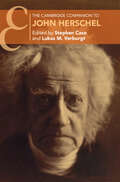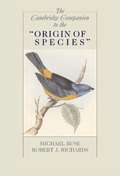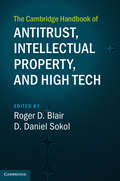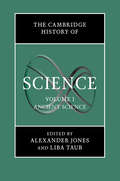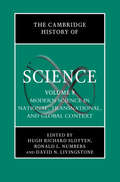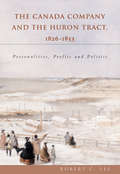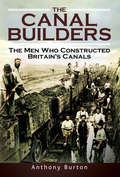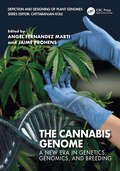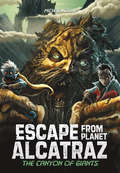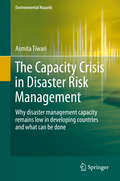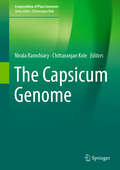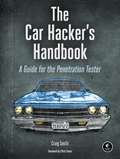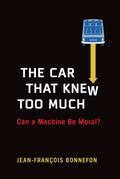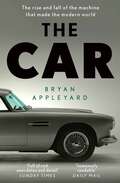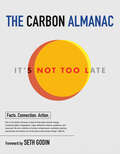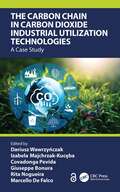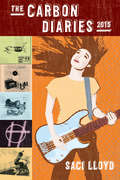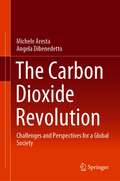- Table View
- List View
The Cambridge Companion to Einstein
by Michel Janssen Christoph LehnerThis volume is the first systematic presentation of the work of Albert Einstein, comprising fourteen essays by leading historians and philosophers of science that introduce readers to his work. Following an introduction that places Einstein's work in the context of his life and times, the book opens with essays on the papers of Einstein's 'miracle year', 1905, covering Brownian motion, light quanta, and special relativity, as well as his contributions to early quantum theory and the opposition to his light quantum hypothesis. Further essays relate Einstein's path to the general theory of relativity (1915) and the beginnings of two fields it spawned, relativistic cosmology and gravitational waves. Essays on Einstein's later years examine his unified field theory program and his critique of quantum mechanics. The closing essays explore the relation between Einstein's work and twentieth-century philosophy, as well as his political writings.
The Cambridge Companion to Galileo
by Peter MachamerNot only a hero of the scientific revolution, but after his conflict with the church, a hero of science, Galileo is today rivalled in the popular imagination only by Newton and Einstein. But what did Galileo actually do, and what are the sources of the popular image we have of him? This collection of specially-commissioned essays is unparalleled in the depth of its coverage of all facets of Galileo's work. A particular feature of the volume is the treatment of Galileo's relationship with the church. It will be of interest to philosophers, historians of science, cultural historians and those in religious studies.
The Cambridge Companion to John Herschel (Cambridge Companions to History)
by Stephen Case Lukas M. VerburgtIt has been said that being scientific in Victorian England meant to be as much like John Herschel as possible. This volume shows readers what it meant to be John Herschel (1792-1871), one of England's most prominent polymaths. Drawing on his published oeuvre and recent scholarship, as well as an immense amount of surviving archival material and correspondence, these essays present the first ever comprehensive account of Herschel's life, work, and legacy. From mathematics and astronomy, to philosophy and politics, the volume sheds new light on his crucial role in the history of Victorian science and explores a wide array of issues in the history of nineteenth-century culture, philosophy, mathematics, and beyond.
The Cambridge Companion to Newton
by Smith George E. Rob IliffeSir Isaac Newton (1642–1727) was one of the greatest scientists of all time, a thinker of extraordinary range and creativity who has left enduring legacies in mathematics and physics. While most famous for his Principia, his work on light and colour, and his discovery of the calculus, Newton devoted much more time to research in chemistry and alchemy, and to studying prophecy, church history and ancient chronology. This new edition of The Cambridge Companion to Newton provides authoritative introductions to these further dimensions of his endeavours as well as to many aspects of his physics. It includes a revised bibliography, a new introduction and six new chapters: three updating previous chapters on Newton's mathematics, his chemistry and alchemy and the reception of his religious views; and three entirely new, on his religion, his ancient chronology and the treatment of continuous and discontinuous forces in his second law of motion.
The Cambridge Companion to Newton
by I. Bernard Cohen George E. SmithSir Isaac Newton (1642-1727) was one of the greatest scientists of all time, a thinker of extraordinary range and creativity who has left enduring legacies in mathematics and the natural sciences. In this volume a team of distinguished contributors examine all the main aspects of Newton's thought, including not only his approach to space, time, mechanics, and universal gravity in his Principia, his research in optics, and his contributions to mathematics, but also his more clandestine investigations into alchemy, theology, and prophecy, which have sometimes been overshadowed by his mathematical and scientific interests.
The Cambridge Companion to the "Origin of Species"
by Robert J. Richards Michael RuseThe Origin of Species by Charles Darwin is universally recognised as one of the most important science books ever written. The Origin of Species is also a work of great cultural and religious significance, in that Darwin maintained that all organisms, including humans, are part of a natural process of growth from simple forms. This Companion commemorates the 150th anniversary of the publication of the Origin of Species and examines its main arguments. Drawing on the expertise of leading authorities in the field, it also provides the contexts - religious, social, political, literary, and philosophical - in which the Origin was composed. Written in a clear and friendly yet authoritative manner, this volume will be essential reading for both scholars and students More broadly, it will appeal to general readers who want to learn more about one of the most important and controversial books of modern times.
The Cambridge Encyclopedia of Darwin and Evolutionary Thought
by Michael RuseThis volume is a comprehensive reference work on the life, labors, and influence of the great evolutionist Charles Darwin. With more than sixty essays written by an international group representing the leading scholars in the field, this is the definitive work on Darwin. It covers the background to Darwin's discovery of the theory of evolution through natural selection, the work he produced and his contemporaries' reactions to it, and evaluates his influence on science in the 150 years since the publication of Origin of Species. It also explores the implications of Darwin's discoveries in religion, politics, gender, literature, culture, philosophy, and medicine, critically evaluating Darwin's legacy. Fully illustrated and clearly written, it is suitable for scholars and students as well as the general reader. The wealth of information it provides about the history of evolutionary thought makes it a crucial resource for understanding the controversies that surround evolution today.
The Cambridge Handbook of Antitrust, Intellectual Property, and High Tech
by Blair Sokol D. Daniel Roger D.This Cambridge Handbook, edited by Roger D. Blair and D. Daniel Sokol, brings together a group of world-renowned professors in the fields of law and economics to assess the theory and practice of antitrust, intellectual property, and high tech. With the increased globalization of antitrust, a better understanding of how law and economics shape this interface will help academics, policymakers, and practitioners to understand the existing state of academic literature, its limits, and its relevance to real-world antitrust. The book will be an essential resource for anyone seeking to understand academic and policy considerations shaping the world of antitrust, intellectual property, and high tech.
The Cambridge History of Capitalism: From Ancient Origins to 1848
by Jeffrey G. Williamson Larry NealThe first volume of The Cambridge History of Capitalism provides a comprehensive account of the evolution of capitalism from its earliest beginnings. Starting with its distant origins in ancient Babylon, successive chapters trace progression up to the 'Promised Land' of capitalism in America. Adopting a wide geographical coverage and comparative perspective, the international team of authors discuss the contributions of Greek, Roman and Asian civilizations to the development of capitalism, as well as the Chinese, Indian and Arab empires. They determine what features of modern capitalism were present at each time and place, and why the various precursors of capitalism did not survive. Looking at the eventual success of medieval Europe and the examples of city-states in northern Italy and the Low Countries, the authors address how British mercantilism led to European imitations and American successes, and ultimately, how capitalism became global.
The Cambridge History of Science: Instruments And Interpretations, To Celebrate The 60th Anniversary Of R .s . Whipple's Gift To The University Of Cambridge (The Cambridge History of Science)
by Alexander Jones Liba TaubThis volume in the highly respected Cambridge History of Science series is devoted to the history of science, medicine and mathematics of the Old World in antiquity. Organized by topic and culture, its essays by distinguished scholars offer the most comprehensive and up-to-date history of ancient science currently available. Together, they reveal the diversity of goals, contexts, and accomplishments in the study of nature in Mesopotamia, Egypt, Greece, Rome, China, and India. Intended to provide a balanced and inclusive treatment of the ancient world, contributors consider scientific, medical and mathematical learning in the cultures associated with the ancient world.
The Cambridge History of Science: Volume 8, Modern Science in National, Transnational, and Global Context (The Cambridge History of Science #Vol. 4)
by Ronald L. Numbers David N. Livingstone Hugh Richard SlottenThis volume in the highly respected Cambridge History of Science series is devoted to exploring the history of modern science using national, transnational, and global frames of reference. Organized by topic and culture, its essays by distinguished scholars offer the most comprehensive and up-to-date nondisciplinary history of modern science currently available. Essays are grouped together in separate sections that represent larger regions: Europe, Africa, the Middle East, South Asia, East and Southeast Asia, the United States, Canada, Australia, New Zealand, Oceania, and Latin America. Each of these regional groupings ends with a separate essay reflecting on the analysis in the preceding chapters. Intended to provide a balanced and inclusive treatment of the modern world, contributors analyze the history of science not only in local, national, and regional contexts but also with respect to the circulation of knowledge, tools, methods, people, and artifacts across national borders.
The Canada Company and the Huron Tract, 1826-1853: Personalities, Profits and Politics
by Robert C. LeeThe Canada Company was responsible for the opening and settling of over two million acres of land in Upper Canada. Author Robert C. Lee focuses his attention on the extensive parcel of land on the shores of Lake Huron that became known as the Huron Tract. His comprehensive research explores the underlying forces leading to the formation of the Company, the intriguing mix of people charged with responsibilities for the Company and the overall impact of its operations, leading to its present-day legacy. The politics of the day, coupled with diverse and colourful personalities – such as John Galt, Tiger Dunlop, William Allan, Thomas Mercer Jones, Frederick Widder, Sir Peregrine Maitland, Bishop Macdonnell and Bishop Strachan – introduce an interesting blend of vision, intrigue, mischief and day-to-day survival strategies that make for compelling reading. Add to this the shareholders perspective of the Company versus the settlers perspective and you have a fascinating glimpse of pioneer conditions. Included are descriptions of early towns such as Guelph and Goderich, as well as background on the Huron Tract township names. "Robert Lee’s outstanding book brings to life the unusual assemblage of characters who were instrumental in the development of Upper Canada’s largest private settlement scheme – the Huron Tract. Their relationships with each other, and especially with the Canada Company for which many of them worked, make a great story." – Lutzen Riedstra, Stratford-Perth Archivist "Robert Lee has vividly recreated the personalities and the political intrigues that were part of the Canada Company’s operation – the largest one of its type in Ontario’s history. The most comprehensive work to date on this fascinating era, this book is eminently readable and a must-have for history lovers. – Ron Brown, author of Ghost Towns of Ontario
The Canal Builders: The Men Who Constructed Britain's Canals
by Anthony BurtonCanal Builders is a classic history book for anyone interested in the development of Britain's canal system. The book, which was first published in the 1970s, is now republished here in a new fifth edition. It takes the reader from the middle of the eighteenth century, to the start of the railway age in the early nineteenth century. Anthony Burton has revised and improved the original text, using new material that he has found in archives since it was first published, and has added many extra illustrations. This is the remarkable story of the many groups of people who were responsible for building Britain's canal system. There were industrialists such as Josiah Wedgwood, who promoted canals to help his own industry, and speculators, financed the projects in the hope of a good return. The work was planned by engineers, some of whom, such as James Brindley and Thomas Telford, have become famous, while others have remained virtually unknown but still did magnificent work. This is also the story of the great, anonymous army of men who actually did the work the navvies. This was the first book ever to study the lives of these labourers in detail. Altogether it is an epic story of how the transport route that made the industrial revolution possible was built.'Well planned and well written There is no better introduction to the early canal age.' The EconomistLinks End Links Author End Author
The Cannabis Genome: A New Era in Genetics, Genomics, and Breeding (Depiction and Designing of Plant Genomes)
by Angel Fernandez Marti Jaime ProhensCannabis is undergoing a remarkable transformation—from a misunderstood plant to a cornerstone of modern medicine, industry, and agriculture. This book bridges the gap between tradition and innovation, providing a holistic exploration of cannabis genetics, breeding, genomics, and its wide-ranging applications. Authored by leading researchers, industry pioneers, and legacy breeders, it offers a unique blend of academic rigor and practical insights.Unlike other resources, this book integrates perspectives from public and private sectors, honoring those who have advanced cannabis cultivation despite legal and social barriers. It recognizes the pivotal role of startups like MyFloraDNA, which invest heavily in groundbreaking research, shaping the future of this extraordinary plant.Key Features: Comprehensive insights into cannabis origins, taxonomy, and genetic diversity. Advanced breeding techniques and applications of tissue culture, CRISPR, and "omics" technologies. Practical strategies for pest management, crop improvement, and intellectual property protection. Forward-looking perspectives on cannabis in personalized medicine, sustainability, and global agriculture. Written for scientists, growers, policymakers, and enthusiasts, this book addresses the economic, social, and scientific dimensions of cannabis. It offers actionable knowledge to drive progress in cultivation, industry, and research.
The Canyon of Giants (Escape from Planet Alcatraz)
by Michael DahlHoping to avoid the Alcatraz guards, Zak Nine and Erro decide to climb down into a deep canyon to hide. But soon the boys see some huge rock formations that move! Zak and Erro are quickly caught by the giant criminals that have been imprisoned in the deep gorge. Some of the giants want to hand the boys over to the Alcatraz guards to gain their own freedom. But a few giants would rather turn the boys into dinner! Will Zak and Erro outwit their captors and get away before becoming the giants' next meal?
The Capability Approach, Technology and Design
by Jeroen Van Hoven Ilse OosterlakenThe capability approach of Martha Nussbaum and Amartya Sen places human capabilities at the centre stage of discussions about justice, equality, development and the quality of life. It rejects too much emphasis on mere preference satisfaction or resource provision and highlights the importance of human agency and freedom. This approach has already significantly influenced different fields of application, such as economics and development studies. Only recently have scholars started to explore its relevance for and application to the area of technology and design, which can be crucial factors in the expansion of human capabilities. How does technology influence human capabilities? What difference could a capability approach make to policies and practices of applying ICT in development processes in the South? How can we criticize and improve the design of technology from the perspective of the capability approach? The authors of this volume explore the implications of the capability approach for technology & design and together create the first volume on this emerging topic.
The Capacity Crisis in Disaster Risk Management
by Asmita TiwariHow can a place be built and managed so that it is safe for people to live? Ironically, many governments and citizens keep on asking the same question after every new disaster. Why, even with high levels of investment in increasing government's capacity to manage disasters, do the impacts of disasters continue to increase? What can the governments do differently? What is the role of local communities? Where should aid agencies invest? This book looks into these critical questions and highlights how current capacity development efforts might be resulting in the opposite--capacity crisis or capability trap. The book provides a new approach for the understanding and the developing of effective local capacity to reduce and manage future disaster impacts.
The Capsicum Genome (Compendium of Plant Genomes)
by Chittaranjan Kole Nirala RamchiaryThis book contains complete information on Capsicum genetic resources, diversity, evolution, history and advances in capsicum improvement from classical breeding to whole genome sequencing, genomics, databases and its impact on next generation pepper breeding. Capsicum is one of the most important Solanaceae crops grown worldwide as vegetables and spices. Due to its high economic value and to meet the demands of enormous population growth amid biotic and abiotic stresses, there has been an ongoing breeding program utilizing available genetic resources with desired traits to increase the sustainable productivity of this crop for several decades. However, the precision breeding of this crop for desired traits only started with the advent of molecular markers. The recent advances in high-throughput genome sequencing technologies helped in the quick decoding of transcriptome, epigenome, nuclear and organeller genomes, thereby enhancing our understanding of the structure and function of the Capsicum genome, and helping in genomics assisted breeding. These advanced technologies coupled with conventional mapping have greatly contributed towards dissection and manipulation of economically important traits more precisely and made less time consuming.
The Car Hacker's Handbook: A Guide for the Penetration Tester
by Craig SmithModern cars are more computerized than ever. Infotainment and navigation systems, Wi-Fi, automatic software updates, and other innovations aim to make driving more convenient. But vehicle technologies haven’t kept pace with today’s more hostile security environment, leaving millions vulnerable to attack.The Car Hacker’s Handbook will give you a deeper understanding of the computer systems and embedded software in modern vehicles. It begins by examining vulnerabilities and providing detailed explanations of communications over the CAN bus and between devices and systems.Then, once you have an understanding of a vehicle’s communication network, you’ll learn how to intercept data and perform specific hacks to track vehicles, unlock doors, glitch engines, flood communication, and more. With a focus on low-cost, open source hacking tools such as Metasploit, Wireshark, Kayak, can-utils, and ChipWhisperer, The Car Hacker’s Handbook will show you how to:–Build an accurate threat model for your vehicle–Reverse engineer the CAN bus to fake engine signals–Exploit vulnerabilities in diagnostic and data-logging systems–Hack the ECU and other firmware and embedded systems–Feed exploits through infotainment and vehicle-to-vehicle communication systems–Override factory settings with performance-tuning techniques–Build physical and virtual test benches to try out exploits safelyIf you’re curious about automotive security and have the urge to hack a two-ton computer, make The Car Hacker’s Handbook your first stop.
The Car That Knew Too Much: Can a Machine Be Moral?
by Jean-Francois BonnefonThe inside story of the groundbreaking experiment that captured what people think about the life-and-death dilemmas posed by driverless cars.Human drivers don't find themselves facing such moral dilemmas as "should I sacrifice myself by driving off a cliff if that could save the life of a little girl on the road?" Human brains aren't fast enough to make that kind of calculation; the car is over the cliff in a nanosecond. A self-driving car, on the other hand, can compute fast enough to make such a decision--to do whatever humans have programmed it to do. But what should that be? This book investigates how people want driverless cars to decide matters of life and death. In The Car That Knew Too Much, psychologist Jean-François Bonnefon reports on a groundbreaking experiment that captured what people think cars should do in situations where not everyone can be saved. Sacrifice the passengers for pedestrians? Save children rather than adults? Kill one person so many can live? Bonnefon and his collaborators Iyad Rahwan and Azim Shariff designed the largest experiment in moral psychology ever: the Moral Machine, an interactive website that has allowed people --eventually, millions of them, from 233 countries and territories--to make choices within detailed accident scenarios. Bonnefon discusses the responses (reporting, among other things, that babies, children, and pregnant women were most likely to be saved), the media frenzy over news of the experiment, and scholarly responses to it. Boosters for driverless cars argue that they will be in fewer accidents than human-driven cars. It's up to humans to decide how many fatal accidents we will allow these cars to have.
The Car: The rise and fall of the machine that made the modern world
by Bryan AppleyardMore than any other technology, cars have transformed our culture. Cars have created vast wealth as well as novel dreams of freedom and mobility. They have transformed our sense of distance and made the world infinitely more available to our eyes and our imaginations. They have inspired cinema, music and literature; they have, by their need for roads, bridges, filling stations, huge factories and global supply chains, re-engineered the world. Almost everything we now need, want, imagine or aspire to assumes the existence of cars in all their limitless power and their complex systems of meanings.This book celebrates the immense drama and beauty of the car, of the genius embodied in the Ford Model T, of the glory of the brilliant-red Mercedes Benz S-Class made by workers for Nelson Mandela on his release from prison, of Kanye West's 'chopped' Maybach, of the salvation of the Volkswagen Beetle by Major Ivan Hirst, of Elvis Presley's 100 Cadillacs, of the Rolls-Royce Silver Ghost and the BMC Mini and even of that harbinger of the end - the Tesla Model S and its creator Elon Musk.As the age of the car as we know it comes to an end, Bryan Appleyard's brilliantly insightful book tells the story of the rise and fall of the incredible machine that made the modern world what it is today.
The Carbon Almanac: It's Not Too Late
by The Carbon Almanac NetworkWhen it comes to the climate, we don&’t need more marketing or anxiety. We need established facts and a plan for collective action.The climate is the fundamental issue of our time, and now we face a critical decision. Whether to be optimistic or fatalistic, whether to profess skepticism or to take action. Yet it seems we can barely agree on what is really going on, let alone what needs to be done. We urgently need facts, not opinions. Insights, not statistics. And a shift from thinking about climate change as a &“me&” problem to a &“we&” problem. The Carbon Almanac is a once-in-a-lifetime collaboration between hundreds of writers, researchers, thinkers, and illustrators that focuses on what we know, what has come before, and what might happen next. Drawing on over 1,000 data points, the book uses cartoons, quotes, illustrations, tables, histories, and articles to lay out carbon&’s impact on our food system, ocean acidity, agriculture, energy, biodiversity, extreme weather events, the economy, human health, and best and worst-case scenarios. Visually engaging and built to share, The Carbon Almanac is the definitive source for facts and the basis for a global movement to fight climate change. This isn&’t what the oil companies, marketers, activists, or politicians want you to believe. This is what&’s really happening, right now. Our planet is in trouble, and no one concerned group, corporation, country, or hemisphere can address this on its own. Self-interest only increases the problem. We are in this together. And it&’s not too late for concerted, collective action for change.
The Carbon Chain in Carbon Dioxide Industrial Utilization Technologies: A Case Study
by Dariusz WawrzyńczakA shift towards implementation of renewable energy has disadvantages, such as power availability, storage capacity, and accompanying costs, and therefore the potential of clean fossil fuel technologies to ensure the stability of electricity generation needs to be reconsidered until these challenges will be overcome. These clean technologies can help prevent the greenhouse effect and, at the same time, guarantee energy security, as coal is a widespread, price-stable raw material that is available in large quantities. This book focuses on the carbon chain, starting from the formation of CO2, through its capture, possible cleaning, to the production of useful products such as dimethylether, methanol, and carbonated cement prefabricates. The comprehensive case study presents the research results of an international team established within the "CCS-CCU technology for carbon footprint reduction using bio-adsorbents" (BIOCO2) project.
The Carbon Diaries 2015
by Saci LloydIt's the year 2015, and global warming is ravaging the environment. In response, the United Kingdom mandates carbon rationing. <P><P>When her carbon debit card arrives in the mail, sixteen-year-old Laura is just trying to handle the pressure of exams, keep her straight-X punk band on track, and catch the attention of her gorgeous classmate Ravi. <P><P>But as multiple natural disasters strike and Laura's parents head toward divorce, her world spirals out of control. <P><P>With the highest-category hurricane in history heading straight toward London, chronicling the daily insanity is all Laura can do to stay grounded in a world where disaster is the norm.
The Carbon Dioxide Revolution: Challenges and Perspectives for a Global Society
by Michele Aresta Angela DibenedettoThis book focuses on carbon dioxide and its global role in our everyday life. Starting with society's dependency on energy, it demonstrates the various sources of carbon dioxide and discusses the putative effects of its accumulation in the atmosphere and its impact on the climate. It then provides an overview of how we can reduce carbon dioxide production and reviews innovative technologies and alternative energy resources. The book closes with a perspective on how carbon dioxide can be utilized reasonably and how mimicking nature can provide us with a solution. Using simple language, this book discusses one of today's biggest challenges for the future of our planet in a way that is understandable for the general public. The authors also provide deep insights into specific issues, making the book a useful resource for researchers and students.

